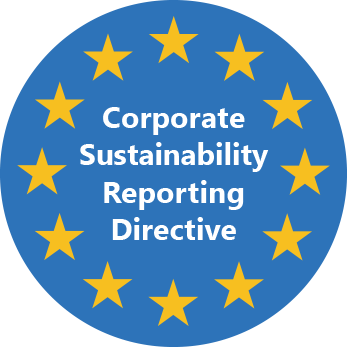Sustainability management in Business Central
EU legislation on sustainability reporting
There is already legislation in the EU that requires large and listed companies (micro-enterprises are exempt) to disclose what they assess as risks and opportunities related to social and environmental issues, as well as the company's direct impact on people and the environment.

This helps stakeholders assess the sustainability of companies as part of the European Green Deal.
|
What is the European Green Deal?
The European Green Deal, finally approved in 2020, is the EU's overall plan to make the European economy sustainable and the EU climate neutral by 2050.
|
|
The European Green Deal consists of?
The European Green Deal consists of a set of ambitious policy initiatives and laws relating to climate, agriculture, biodiversity, energy, circular economy, forests and pollution in Europe.
|
CSRD - Requirements for sustainability reporting
However, as the sustainability information that companies currently report is not sufficient, the European Commission has adopted a series of common standards, so that companies in Europe are supported to communicate and manage their sustainability results more effectively, which also means that they get better access to sustainable finance.

From the 2024 financial year, the first companies are required to report according to the EU Corporate Sustainability Reporting Directive (CSRD).
|
What is the CSRD Directive?
The CSRD stands for Corporate Sustainability Reporting Directive and is a directive that sets the overall requirements for companies within the EU to report on sustainability.
|
Companies covered by the directive must now report on sustainability in a separate section of the management review in their annual report.
The CSRD requires sustainability reporting to be at the same level as financial reporting and to include a statement from an auditor or independent auditor.
The reporting should include the company's sustainability strategy and information on significant impacts, risks and opportunities in the areas of environment, climate, social and governance. It should be integrated into both the strategy and the business model and supplemented by information on policies, activities and targets.
Furthermore, the reporting should cover both the company's own sustainability aspects and the significant impacts throughout its value chain.
All companies covered by CSRD must use the full set of ESRS standards, while listed SMEs can choose to use the specific LSME standard (ESRS for Listed Small- and Medium-sized Enterprises).
Who must report on CSRD?
Both listed and unlisted companies that are included in accounting class C are covered by the CSRD Directive. In addition, listed SMEs, i.e. small and medium-sized enterprises, are covered by the requirements. However, micro-enterprises are exempt.
In addition, CSRD will impose special reporting requirements for companies located outside the EU with subsidiaries or branches in the EU and a turnover in the EU of at least 150 million EUR. Danish subsidiaries in such groups may be affected by the CSRD reporting requirements.
Until the requirements come into force, subsidiaries must prepare sustainability reporting for their own company if the subsidiary itself is included in accounting class C large.
When is the first reporting required?
The CSRD reporting requirements will be implemented gradually over the years 2024 – 2028. The requirements apply to financial years starting on:
1. januar 2024 og derefter:
Listed companies with more than 500 employees
From 1 January 2024 and thereafter:
Listed and unlisted companies that belong to accounting class C large
From 1 January 2025 and thereafter:
Listed SMEs, except micro-enterprises.
From 1 January 2028 and thereafter:
Certain companies from third countries, i.e. companies located outside the EU.
Sustainability Management
Sustainability management, or sustainability management, has quickly become a central area in the operation of modern business.
This is because companies have become more aware of their social responsibility and thus the need to tackle environmental and social challenges, and at the same time are being pressured by new legislation in the area.
|
Why Sustainability Management?
The goal of sustainability management is to create a sustainable and equitable system by balancing economic, social and environmental considerations.
|
Businesses play a key role in shaping both the future of the planet and the well-being of people. The negative consequences of unsustainable business practices, such as climate change and social inequality, are increasingly evident. That is why many companies are choosing to take responsibility and work actively to reduce these impacts.
Sustainability Management in Business Central
Business Central has built-in sustainability management functionality to help companies monitor and manage their environmental impact.
Sustainability features are designed to enable companies to accurately and easily monitor and regulate their environmental footprint by tracking various greenhouse gas (GHG) emissions.
The sustainability management functionality in Business Central also supports the basic process of collecting emissions data via sustainability journals or purchasing documents, as well as recalculating emissions to CO2 equivalent.
You have the option of either entering the known emissions data manually or using the options for calculating emissions footprints that are built into Business Central.
|
Please note
Calculating carbon footprints in Business Central using built-in formulas is only available when using Sustainability Journals.
|
Enhanced Sustainability Management in Business Central 26
As part of Dynamics 365 2025 release wave 1, Microsoft is releasing Business Central 26 in April. It introduces a wide range of new features, including new and improved capabilities in sustainability management.
With Sustainability Management capabilities in Business Central 26, you can:
Gathering sustainability information
- Use sustainability journals and purchasing documents to collect data directly or via formulas. Track emissions by company, country, region, or facility, and purchase carbon credits directly in Business Central.
- Import emission factors from external sources to ensure accurate calculations using exposed APIs.
Track your sustainability progress
- Use the modern sustainability role center to monitor all your sustainability information and various KPIs. Scorecards and targets help you easily track progress against your baselines and goals.
Get easy insights and reporting
- Leverage standard reports or modern Excel reporting with analytical views for your sustainability records. Compare your sustainability records to statistical or GL records using financial reports, and report on various greenhouse gases or CO2 equivalents, as well as water and waste management.
- Customize reports to focus on specific sustainability metrics relevant to your business, ensuring tailored insights for your unique sustainability goals and reporting requirements.
These capabilities provide comprehensive tools for effective sustainability management, so you can effectively track, analyze, and report on your environmental impact.
CSRD reporting in Business Central
If you want to avoid outright integration for ESG reporting, in Business Central 26 you will be able to simplify your CSRD reporting by printing reports with repared data and taxonomies.
CSRD functionality
By drawing on various sources of transactional data, Business Central allows you to easily configure taxonomies.
When you start the initial setup, you will see that it fits standard demo data. However, the setup is easy to customize to suit your company's specific business needs.
Once you have completed the setup, you can aggregate existing data based on the taxonomies.
If you do not have a reporting tool integrated, you have the option to create a report layout that serves as a preparatory document for your CSRD reporting.
|
Availability
Please note that the functionality for generating a CSRD preparation report will only be available in Business Central 26 and released in September 2025.
|
